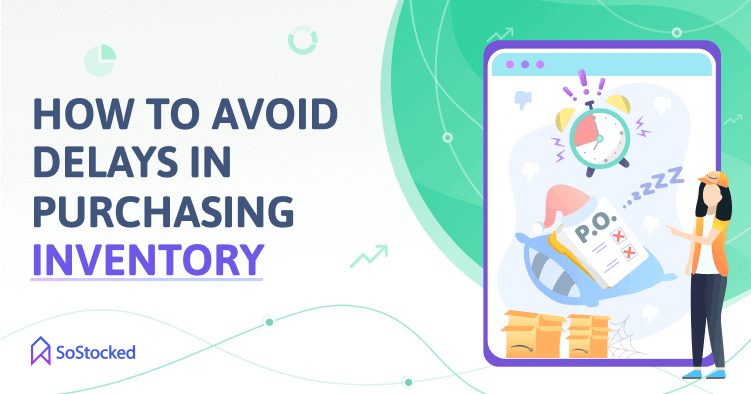
Order Procrastination: How to Avoid Delays in Purchasing Inventory
Beat Order Procrastination to Prevent Stockouts
For sellers with a good, up-to-date inventory system, the decision to purchase inventory is an easy one and made with little to no hesitation. For others, the decision to place that order is much more difficult to make. If you are one of those people, there are various reasons why this could be happening to you.
Maybe you have been thinking about placing new Purchase Orders (POs) for weeks, but you have not gotten around to it. You may be suffering from a malady I like to call order procrastination.
Order procrastination is the act of putting off placing inventory orders until you find out it’s too late and ultimately it ends up costing your business dearly in many ways.
But what is behind this order procrastination? Is it because the process is so long and tedious to complete? Are you too busy with other things? Struggling with a lack of funds to pay for your orders?
Whatever your reasons, the outcome is the same: mounting avoidance stress — that stress you feel when you delay doing something and know it will get worse and worse the longer you avoid it — followed by finally executing on the POs, only to find you haven’t left yourself enough time and will have to either incur expensive air freight costs or stock outs.
There are various reasons why people delay ordering. Understanding the reasons that underlie your specific mode of procrastination will help you to break the costly habit. In this post, we’ll explore what order procrastination is, why it occurs, and what you can do to overcome it.
In this Purchasing Inventory guide, we’ll take a look at:
What is Order Procrastination?
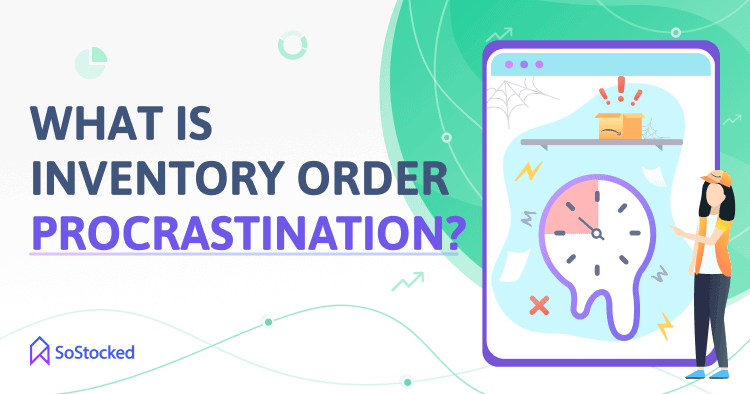
As the term implies, order procrastination is the deliberate act of putting off what needs to be done to purchase a new batch of inventory.
Some delays are necessary, such as waiting on permission (e.g., to get POs approved by you or your PO manager) or waiting on information (e.g., freight forwarder quotes). These “necessary” delays should be all worked into your lead times when inventory planning to ensure you don’t order too late and stock out.
However, many delays are also avoidable. For example, you choose to delay purchasing orders because you find this task:
- Difficult (e.g., you place your orders over the phone or via email, which makes POs hard to track. When suppliers ask for your order/transfer details, you have to dig through your email to try to piece those details together.)
- Boring
- Frustrating (e.g., going back and forth with your suppliers for clarifications on your POs because you forgot to mention important details during the phone call or in your email)
- Unrewarding or unsatisfying (i.e., other tasks are simply more fun to do)
- Ambiguous or unstructured (i.e., you find managing POs ambiguous because you don’t have a workflow that outlines the steps that you and your team need to follow to get POs done and approved on time)
Pro tip: Follow my step-by-step guide to simplifying the Amazon Purchase Ordering process for sellers.
Strategies for overcoming order procrastination will vary depending on why it happens in the first place. But before we get into that, let’s discuss the consequences of delaying purchasing inventory in great detail to help you understand why it has to stop.
What are the Consequences of Delaying Purchase Orders?
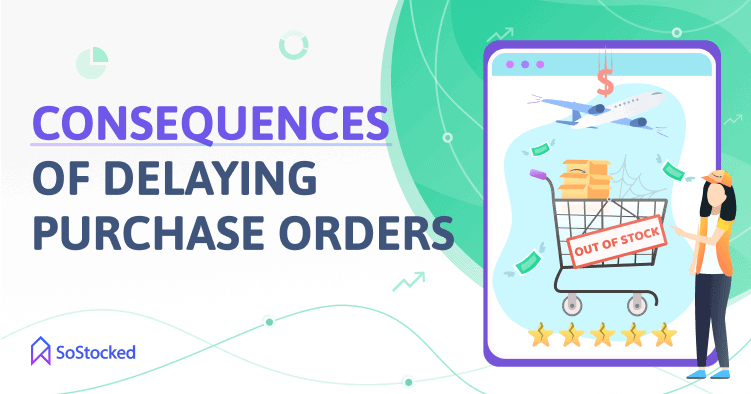
Not addressing your order procrastination issues could be costing your business tens of thousands of dollars, as it often leads to:
Stockouts
Is your top seller selling faster than expected? Don’t wait until your stock level reaches zero before calling your 3PL warehouse to send in more stock or your supplier to produce another batch of inventory.
Always keep an eye on your Days of Supply (DoS) in Seller Central and use that to work out a lead time that will help you prevent stockouts. Set a reorder point that tells you when it’s time to replenish products that are running low on stock. Your reorder point should also give your supplier, freight forwarder, and 3PL warehouse/prep center ample time to deliver your goods to FBA.
If your current stock at Amazon only lasts until March 1st, and you’ve got 10 days’ worth of buffer stock at 3PL and 40 days lead time, then you need to reorder 50 days before the day your product runs out of stock. Having a reorder point in place helps you to stick to a schedule that prevents you from delaying purchasing inventory.
Also, be aware of the fact that stockouts can occur when you order too little due to miscalculations in your reorder quantity. For example, using Amazon’s restocking recommendation tool as the only reordering system for your business can be problematic because:
- Amazon only looks at total recent sales and does not calculate using a daily adjusted sales velocity which would factor out sales spikes and stockouts.
- Amazon’s restock recommendation algorithm also doesn’t factor in separate lead times for supplier versus your 3PL, order versus transfer (warehouse to FBA) frequencies, inventory on hand at your 3PLs, or inventory on-order at your suppliers, and marketing plans (projected sales growth from advertising or promos).
While there are a few settings for tweaking some of these things, the option for customization (i.e., factors you want to include and exclude from your calculations) is sadly lacking. If one important variable is factored out of the equation, it can change your desired outcome. Either you wind up ordering too much or too little stock.
Therefore, if you’re hoping to solely rely on Amazon’s restock suggestions because you can’t find the time to develop your own reordering process and really plan out your inventory restocking, think again.
Pro tip: Use a highly customizable inventory system that lets you set variables that you want to factor in and out of your forecast data for more accurate results. In SoStocked, you can remove anomalies like stockouts and sales spikes (that are not going to occur again) and factor in restock limits, seasonality, average sales velocity, trends, and Blackout dates. And to make sure you reorder on time and in the optimal order quantity, you can also set your product’s minimum (aka buffer stock), maximum stock at FBA fulfillment centers/3PL warehouses, and order schedules per SKU. Then, choose whether to calculate your min/max in days or in units, although we recommend setting it in days to account for seasonality.
Expensive Express Shipping
It’s a known fact that shipping inventory by express air costs a fortune. That’s why sellers avoid getting into that situation as much as possible. How? By having full control over their inventory.
If you just let Amazon’s restock suggestions tell you when to restock, which as I’ve explained doesn’t factor a lot of important variables into the equation, you could get into trouble.
For instance, Amazon recommends that you restock now so you email your supplier to place a new inventory order. However, the new lead time they’ve given you is longer than usual because you ordered too close to their Blackout Dates (Chinese New Year or Golden Week). There’s no way your order will arrive on time by sea, so you’re forced to ship it by express air.
Unfortunately, you can’t include Blackout Dates in Amazon’s restock recommendation tool, which means, they’re most likely to give you the same restocking forecast again next year–unless you manually adjust the supplier lead time before the Blackout Dates. Remember, this is going to be an annual occurrence, so if you’re always too busy with other tasks, keeping track of Blackout Dates might be difficult.
Pro tip: Use SoStocked to blackout certain days or weeks in your product’s forecast. You also have the option to repeat this forecast setting annually. Check out our Supplier Blackout Dates help article to learn more.
When you have full control over what factors should and shouldn’t go into your calculations, and automate reorders based on those forecast settings, inventory management becomes much more manageable. More importantly, you become less dependent on expensive express shipping as you’re able to plan your inventory well in advance.
Lost Rankings
Amazon ranks products based on traffic, conversion rate, and, essentially, sales velocity, among other things. The more sales you make per day, the better your ranking will be, which means more traffic and more sales.
If you run out of stock because you couldn’t ship your inventory into fulfillment centers on time, Amazon may hide your listing from the search results pages. Or, they may still allow you to sell by allowing customers to pre-order your product (customers can still place an order but the units will be shipped at a later date). However, some customers won’t be too happy to see that they’ll have to wait many days for their orders to arrive, so they will likely turn to your competitors.
Every day without stock potentially hurts your rankings and certainly your ability to generate income. Worse, you’ll need to invest more time and money in trying to regain your lost sales and rankings.
Related: 7 Top Amazon Metrics Sellers Should Track
Bad Decisions
You may make hasty decisions when you are under the gun. Worse, you or the manager responsible for making that poor decision may decide to hide that mistake or many other mistakes, which if not corrected immediately, could bring down your business in the future.
For example, when you delay fixing the errors in your holiday inventory forecast and shipping deadlines are fast approaching, you risk making an uninformed decision for your seasonal business.
Because you’re using inaccurate forecast data, you may end up over-or under-ordering, which can have an impact on your bottom line, Amazon IPI score, and restock limits.
Taking the time to improve the accuracy of your forecast data will help you make sound decisions that could protect your business from stockouts, overstocking, and other inventory management problems.
Related: How to Automate Amazon Inventory Forecasting for Accurate Reordering
Why Do You Delay Purchasing Inventory (and How to Stop it)
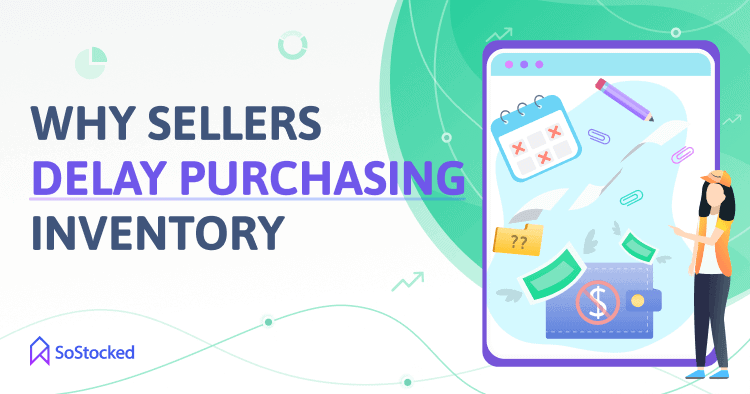
Everyone is different and understanding why YOU procrastinate will help you to address the underlying issues beneath your reasons.
Cash Flow Issues
Some sellers experience order procrastination because they don’t feel they have enough cash to pay for their inventory. Maybe too much money is tied up in slow sellers and the costs associated with storing these products. So, they try to wait till the last second which is often, at that point, too late.
Solution: Try to free up capital by liquidating or putting your slow-moving items on sale. You may not recover all of the money you’ve invested in that inventory, but moving them eliminates long-term storage fees and other holding costs as well as recovering the cash tied up in that slow-moving stock.
It’s also good practice to audit your expenses quarterly and remove expenses you no longer need. These include subscription services you’re no longer using and unsuccessful PPC ad campaigns, and other low/no ROI expenditures.
Additionally, re-coding your HTS codes with the help of a product sourcing expert like Honu Worldwide can also do wonders for your profit margins. HTS codes are assigned to all international goods to determine their appropriate duties.
If your inventory is coded incorrectly, you may be over- or under-paying your duties. Either way, you’ll want to make sure you’re using the right code to save money and stay compliant with the law.
Finally, get back the money Amazon owed you, even if they’ve rejected your requests before. Use a reimbursement system like Seller Investigators that deeply understand how Amazon’s reimbursement process works. An organization that knows what claims they can and cannot recover, and how to get those recoverable claims approved, can help you get the repayments you deserve, helping you to increase profit margins.
Related: How to Increase Profit Margins
Lack of Data Organization
It’s difficult to stay organized if you don’t have an inventory management system that can store all your data in one place. When it’s time to make your marketing plans such as deciding what product(s) to market heavily on Prime Day, Black Friday, or Christmas, you need to look at your inventory data to take the guesswork out of your decisions.
But when there’s too much data, and it’s too cluttered, it’s easy to become overwhelmed and get stuck guessing. It may even lead to stockouts and lost sales. Plus, second-guessing your decisions only increases your stress levels. The result? You procrastinate. You delay placing your holiday inventory orders until it’s too late.
Solution: SoStocked is designed, in part, to streamline inventory data. Below is a list of some features in our Amazon inventory management software that illustrate how to organize and share your data with your teams efficiently.
If you are not at the point of adopting software like SoStocked, the tips in this section are also something that you could apply on a spreadsheet level as well. (See my Free Amazon FBA Inventory Management Spreadsheet)
Custom Dashboards That Organize Inventory
Create individual dashboards based on the data you want to see, all done through filtering and grouping processes. For example, you can create an Inventory Dashboard for a specific supplier so that you only view products from that specific supplier. Simply use the filtering tool to remove all irrelevant data, hit Apply Filters > Add as a New Dashboard > Save.
Order Tracker For Tracking Inventory Progress
Use our built-in order tracker to find out What PO is In Production, what’s En Route and to where, who has possession of your inventory, where it’s coming from (supplier, warehouse) and where it’s going?
Product Tagging Tool
Tag your products based on your specific criteria. For instance, you may have certain products that you’ll want to promote heavily during Black Friday. Assign a tag (e.g., Black Friday) to those products so you can easily find and view them when you search them by that tag.
Turn Off Amazon Marketplaces
Control the data you want to see by turning off certain marketplaces. Suppose you’re receiving a multitude of data about emerging markets like Brazil, but you don’t want to sell in that marketplace, simply go to Settings > Connected Amazon Store > Turn Off Brazil. Once these changes are applied, all data about the Brazil marketplace in SoStocked will be hidden until you turn that marketplace back on.
Inventory-Minded Marketing Planning
Incorporate your marketing plans into your inventory plans to make better decisions. Important marketing data that you can add are additional sales growth, trends, Lightning Deals, email or influencer campaigns, among other marketing factors. If you have a seasonal FBA business, be sure to use the Seasonal Sales Spikes feature, too. It is a tool for adding an increase (such as a Christmas spike) or a decrease in sales for a specific date range. That change will then show up inside of your forecast and factor into your recommended inventory transfers and orders.
Liquidation Reports
Create a liquidation report on products that are moving so slowly that it may not be worth it to keep them around anymore. This tool lets you organize slow sellers so you can quickly decide whether to keep them and improve their sell-through or just liquidate them.
Related: How to Organize Inventory
Too Busy With Other Things
As business owners, we are usually understaffed or have a million other things to do because we have not delegated enough within our business.
Sometimes, we’re also too busy putting out a dozen little fires (emergencies) we end up neglecting other duties, which only creates more fires to be put out. Worse, you continue to neglect those other duties to the point that you address them under a time constraint and they never receive your full attention.
Solution: Use SoStocked to automate repetitive tasks like reordering and delegate them to an Amazon virtual assistant. This way, all you need to do when it’s time to replenish is to keep your inventory forecasts up-to-date and approve POs, allowing you to truly focus on income-generating tasks and worry less about the admin side of things.
Check out my comprehensive Inventory Management Training Guide for more tips on improving your inventory management processes. You can use the free tools and resources within that guide to train your VA to become more adept at using an inventory management system.
Not Setting a Reorder Point
As mentioned earlier, Reorder Point (ROP) is the stock level at which your inventory (at FBA or 3PL) needs to be replenished to avoid a potential stockout. While it’s easy to calculate the ROP for one product, things can quickly get out of hand the more SKUs you manage.
Imagine calculating ROPs for more than 50 products, which involves keeping a close eye on each product’s inventory levels at Amazon FBA. Without a system to help you stay organized, you can get overwhelmed easily. So, expert coordination at this point is vital.
Solution: First, calculate your reorder point using this formula:
Days of Buffer Stock + Days of Lead Time = Reorder Point
Reorder date looks at your stockout date and adds your reorder point to that. So, if your reorder point is 90 days and stockout is Feb 12th. You need to place your order 90 days before that date.
Second, automate your restocking process through inventory management systems like SoStocked, which allow you to automatically set your reorder points for each SKU quickly and efficiently. Within the software, you’ll set your minimum and maximum stock (in days or units) and your order frequency/schedule. The software then automatically alerts you when a product’s reorder point is coming due so you’ll never have to miss your reorder date again.
Related: Amazon Reorder Point for Efficient Restocking
Inefficient Purchase Order (PO) Systems
Inefficient PO processes like placing orders via phone call or email just add more admin work and long email trails. And if you’re not using a standard PO template for each product, you may also end up providing your suppliers with incomplete order information.
When your supplier suddenly seeks clarifications, you’d need to dig through a pile of emails and documents to find the information they’re looking for. Resolving this issue can be time-consuming and can lead to ordering delays that may either result in express shipping or a stockout.
However, building out purchase orders can often be a lengthy process that only gets more involved as you scale up your business.
The bottom line is, purchase orders are great tools as long as they work efficiently. However, when they become a burden on you (or your busy staff), you become less motivated to carry out your PO-related tasks.
Solution: Purchase Order automation allows you to remove most of the admin burden from your ordering process. It eliminates manual processes like filling out line after line of each SKU in multiple POs and then emailing them to your suppliers.
With automation, luckily, you can digitize and centralize purchase orders and work orders (warehouse instructions).
- When POs/WOs are properly organized, you’ll have all of the order details close to hand, such as supplier information, product name, order quantity, price, delivery details, and so on.
- Centralized: Keeping POs or WOs stored on the same platform allows your inventory and accounting teams to access those files whenever they need.
Related: Guide to Simplifying Your Amazon Purchase Ordering Process
Decision Fatigue
Many sellers have developed the habit of waiting until the end of the day to create purchase orders as they are often dealing with suppliers from the other side of the world. This means they have to stay up late after a long day’s work to converse with their suppliers. However, at this point, they are just drained and that’s where decision fatigue starts to creep in.
Decision fatigue happens when after making so many decisions, your ability to make additional decisions deteriorates. It can lead to bad decisions, impulse buying, or procrastination.
Solution: Fighting decision fatigue may begin with restructuring your day. If dealing with your suppliers after a long day’s work is causing you to make hasty decisions, try to do it first thing in the morning. This allows you to put your best energy toward it. If you have to wake up 30 minutes earlier, that may be an option to help you to get a headstart on important tasks such as these.
It’s also wise to plan important decisions such as order details well in advance. This way, you can have calm, productive interactions with your suppliers rather than rushing things, which is not conducive to good relationships.
Operating On Outdated Lead Times
We often don’t have much say over our supplier lead times. In fact, production and shipping conditions are normally set by supplier constraints and the overall state of global shipping. External factors like raw material shortages, factory closures, or port backlogs can also impact your lead times.
So, if you don’t stay in touch with your suppliers and freight forwarders to know your true lead times, you might end up assigning outdated lead times to your inventory order workflow and inadvertently cause delays.
Solution: In cases like this, it pays to begin a habit of following up on any order delays to ask why your supplier is taking so long to complete, so you’ll know how you need to adjust your plans in the future to be better prepared. If your supplier is experiencing delays in procuring raw materials for your inventory, consider ordering additional raw materials in advance in the future.
You might also want to think about reworking your payment structure with your supplier to avoid tying up your capital in inventory that’s going to take months to arrive. For example, make a 30% down payment and then pay your outstanding balance (70%) in several installments.
For example, if you are splitting your shipments between ocean and air freight your supplier may agree to let you pay your remaining balance on the shipments as they ship out. So if you ship ocean freight 30 days before you send the air shipment, you would pay your supplier for these two shipments at separate times 30 days apart, which helps to alleviate cash flow constraints.
You’d also want to ask your supplier, freight forwarder, or 3PL manager well in advance and often if they’re expecting any delays or changes to their lead times. Then, apply these changes to the lead times you’ve set in your inventory management system to keep your forecasts up-to-date. If the reason for the delay is container shortages, consider sending a portion of your shipment by air while the rest by ocean to ensure you don’t stock out.
Related: Amazon FBA Freight Forwarder Tips to Avoid Stockouts
You Just Hate Inventory Management
Sometimes, the most logical explanation is the correct one — you just straight-up hate inventory management.
If your to-do list for the day mainly consists of tasks you don’t enjoy, you will try hard to avoid them. Usually, in inventory management, this list typically includes being neck-deep in lots of numbers and spreadsheets, requesting quotes, reviewing invoices, and sending and answering emails from suppliers or warehouse staff.
The more you think about how much you hate doing these tasks, the greater your resistance. So instead of tracking your POs, you end up doing something less important but more enjoyable — like checking Facebook.
Solution: The first step is to take a pause and figure out why you really hate inventory management. Identify the bad habits you’ve developed over the years.
Is there any specific task that you always put off carrying out?
You probably don’t find it as rewarding or enjoyable as, let’s say, marketing. So, you tend to squeeze it in before the deadline waiting till the last second to get it done.
If that’s the case, try breaking tasks with long deadlines into multiple smaller tasks. For example, verifying lead times as the first task one day, calculating your reorder point the next day, confirming your forecast calculations the next, and so on.
Don’t forget to find ways to reward yourself as you complete each mini-task to make things enjoyable.
What are your thought patterns around tasks you hate? (e.g., It’s too difficult. I’m not smart enough to do this. What if I do a bad job?)
Whenever you feel like inventory management is challenging, try to go back to where you felt like you were doing well. In most cases, you’ll find out you missed some concepts or didn’t completely understand something before you jumped into the next level.
I always tell people to learn things on a gradient scale. If something’s overwhelmingly difficult, you may have tried to jump too high on the gradient. So, you have to step back and get back to the basics.
Stepping back and regaining confidence and stability around this part of your business by nailing the basics can help you to improve your relationship with the tasks themselves.
Additionally, you can overcome negative thought patterns around tasks you hate by improving your knowledge of, responsibility for, and control over them. Remember, you tend to avoid things when you feel anxious about them, fearing that you will fail.
Overall, you should have a clear picture of your own work habits, so you stand a better chance of improving them. And that clearer picture may just be that you don’t want to do those tasks yourself. If so, maybe it’s time to let go of those tasks you don’t like and pass them off to a VA who loves that kind of work. There are people like that, you know.
Get Things Done Quickly with SoStocked
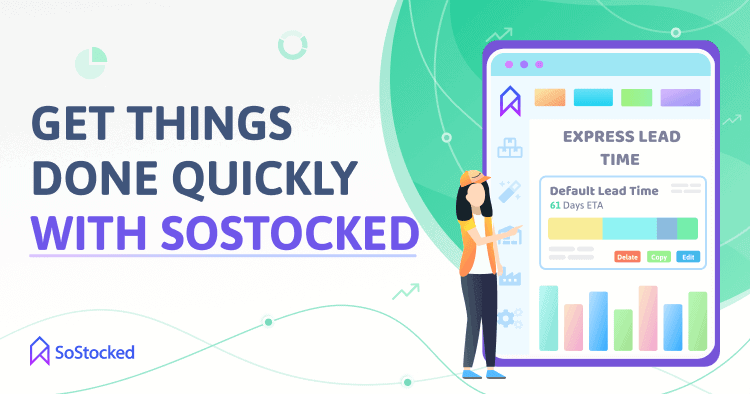
Inventory management automation is the most efficient way to get things done on the supply chain side of your business. Instead of pulling sales reports from Amazon, reinventing your forecast calculation each time, filling out POs manually, or sifting through email threads from your supplier to follow up on your last order, you do everything on a digitized and centralized platform.
In SoStocked, you’ll find plenty of tools and features that can help make inventory management easier.
Customizable Forecasting
Improve the accuracy of your inventory forecasts by excluding sales spikes and stockouts or including past sales, restock limits, lead times, Blackout Dates, and marketing data into your calculations.
Simultaneous Forecasting
Use this tool to forecast both supplier orders and warehouse transfers simultaneously to ensure you stay in stock at Amazon at all times.
If you’re using a 3PL, you need to have a transfer forecast for every SKU in addition to the standard order forecast. You may even need a third, for express shipping calculations if you can ship units by express air during unavoidable stockouts.
You can use our Express Lead Time tool to determine how many units you need to send by regular shipping versus express air.
Advanced Purchase Order and Work Order System
Create a standard PO template for all of your orders, assign lead times, and track POs through the Order Tracker dashboard. Using a PO system eliminates inefficient, manual processes, such as manual data entry, long email trails, and placing orders via text messaging or phone call.
Our secondary order management system that works alongside our POs is our Work Order system. Instead of supplier lead times, this system uses transfer times to track your shipments from a 3PL warehouse or prep center to FBA. You can also include a set of instructions to instruct your warehouse staff on what to do with both of your existing and incoming inventory (e.g., store, create multi-packs or bundles, or transfer to FBA).
Order Tracker
Once you assign a lead time to your PO, you use our built-in Amazon inventory order tracker to monitor the progress of your shipment — from In Production > Shipping > Arrival at FBA or 3PL.
Our Order Tracker uses a Kanban board that automatically moves shipments from In Production to En Route to 3PL warehouse and FBA based on their assigned lead times.
Restock Limits Tool
Make sure you don’t send too much stock into FBA by factoring your Amazon Restock Limits by storage-type into your inventory data. To do that in SoStocked, choose a specific marketplace you want to calculate forecasts for, enter your current restock limits for that marketplace, and click Update to recalculate your forecasts automatically based on your restock limits. The calculations will show you the optimal unit quantity per SKU that you should ship to FBA so you don’t max out your restock limits with slow movers blocking best sellers.
Watch this quick tutorial to better understand how our restock limits functionality works.
Min/Max Restocking
Set minimum (buffer stock) and maximum stock quantities on both your 3PL warehouses and FBA fulfillment centers. Once set, the software will automatically alert you when you need to place a new order or transfer and for how many units.
You can set your Min-Max in days or in units. However, I recommend choosing In Days as this will fluctuate with your stock level depending on seasonality.
Seller Dashboards
Monitor all-important inventory management KPIs by creating a dashboard for each. In SoStocked, you can customize the following dashboards to keep track of your assets and performance:
- Inventory-on-Hand
- Inbound Shipments
- Stockout Risk Report
- Overstock Report
- Liquidation Report
- Slow-Sellers Report
- Sell-through Rate
Bonus: Keep your skills up-to-date by joining my free webinars on Storage-Type Inventory and Logistics Strategies!
Invest in Automation to Beat Order Procrastination
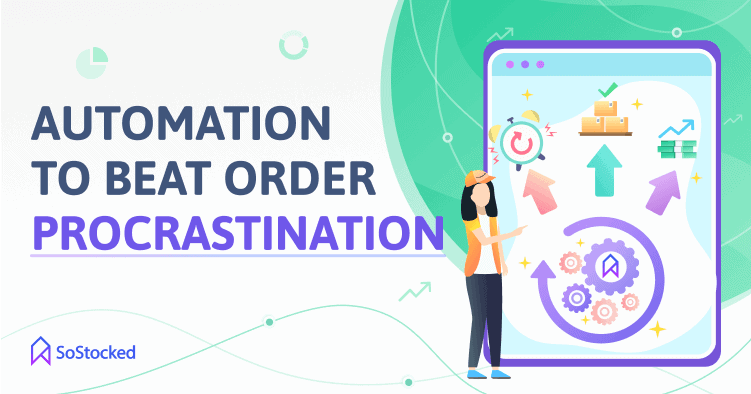
Sellers delay purchasing inventory for different reasons–cash flow issues, inefficient processes, preoccupied with other things, and many others.
But if there’s one explanation as to why all of these things happen, it’s the lack of an automated system that allows people to get things done efficiently. Increased efficiency means it takes you less time to complete a task, or you’re able to do more within the same amount of time.
When you automate inventory processes that you find difficult, it reduces stress because you know things will be done quickly and accurately so you no longer have to drag your heels to do them. You can rest easy knowing that your reorder alerts, seller dashboards, forecasts, purchase orders, work orders, order trackers, and other processes are being managed without interruption.
Once an efficient system is implemented, all you have to do next is to keep all your data organized and up-to-date, monitor your shipments and inventory levels at FBA/3PLs, and analyze reports to inform your decisions.
Need more information?
- Send Message: We typically reply within 2 hours during office hours.
- Schedule Demo: Dive deeper into the nuances of our software with Chelsea.
- Join Live Upcoming Webinar: New to Amazon inventory management? Learn three inventory techniques you can implement right away.
 Start Your Free Audit
Start Your Free Audit